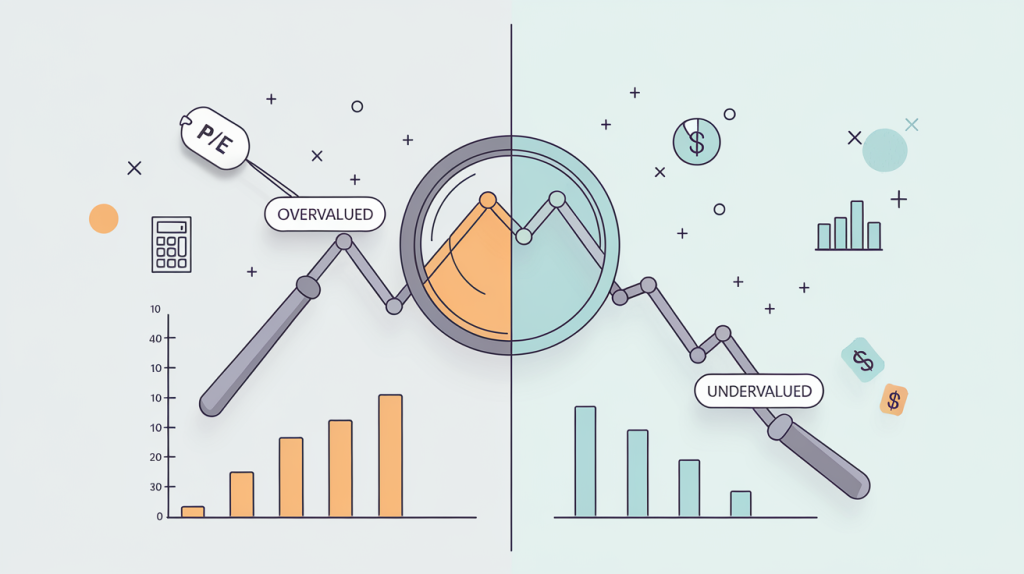On This Page
Table of Contents
Let’s face it—stock prices don’t always tell the whole story. Sometimes, the market gets it wrong. That’s why savvy investors don’t just look at price tags; they dig deeper to understand intrinsic value. This is the true worth of a company based on its actual financial performance and potential—not just what folks are willing to pay on the stock exchange.
That’s where financial ratios come in. Think of them as quick-check tools that offer big-picture insights into whether a stock is trading for more (overvalued) or less (undervalued) than it’s really worth. Whether you’re analyzing a blue-chip giant or a scrappy start-up, ratios like P/E, PEG, and P/B can help you make sense of the numbers.
Ready to pull back the curtain on stock prices? Let’s break it down.
P/E Ratio: The Valuation Benchmark
Ah, the classic Price-to-Earnings (P/E) ratio—the first stop for most investors. It tells you how much investors are willing to pay per dollar of a company’s earnings.
Formula:
P/E = Market Price per Share ÷ Earnings per Share (EPS)
- Trailing P/E: Based on the past 12 months’ earnings.
- Forward P/E: Uses projected earnings for the upcoming year.
A high P/E might suggest a stock is overvalued—unless the company has high growth potential. On the flip side, a low P/E could be a sign of undervaluation… or a warning sign of trouble ahead.
For example, undervalued gold mining stocks with strong financial ratios often stand out when compared to their industry peers. If you’re curious to see how this plays out in the real world, check out our guide to the Best Gold Stocks in Canada—a practical look at ratio analysis in the gold sector.
📌 Watch out for:
- Comparing companies in different sectors (tech P/Es tend to be higher than industrials).
- Using outdated earnings data.
PEG Ratio: Adjusting for Growth
The P/E ratio’s cool cousin, the PEG ratio, adds a layer of context by factoring in growth.
Formula:
PEG = P/E ÷ Annual EPS Growth Rate
So, a stock with a PEG under 1 is often seen as undervalued relative to its growth potential. For example, a company with a P/E of 20 and expected growth of 25% would have a PEG of 0.8—pretty attractive, right?
But don’t get too excited just yet—growth projections aren’t always spot-on.
📌 Be cautious:
- Growth rates are just forecasts, not promises.
- The PEG is less useful for companies with volatile or unpredictable earnings.
Price-to-Book (P/B) Ratio: Asset-Based Valuation
Want to know what you’re paying for a company’s net assets? Enter the P/B ratio.
Formula:
P/B = Market Price per Share ÷ Book Value per Share
It compares a company’s market price with the value of its tangible assets (minus liabilities). A P/B under 1 might suggest the stock is undervalued—especially if the business isn’t in distress.
But be warned: P/B is more meaningful for asset-heavy businesses like banks or manufacturers. For tech firms, not so much.
📌 Consider:
- Sector norms (tech companies tend to have higher P/Bs)
- Whether book value includes intangible assets like patents or goodwill
Dividend Valuation: Price-to-Dividend Ratio
If you’re in it for income, the Price-to-Dividend (P/D) ratio is your go-to. It’s the flip side of the dividend yield and tells you how much you’re paying for each $1 of annual dividend income.
Formula:
P/D = Stock Price ÷ Annual Dividend per Share
For dividend investors, this helps identify value in income-generating stocks. A high P/D could mean the stock is overpriced for its dividend; a low P/D might scream “value.”
📌 Key checks:
- Look at the payout ratio (is the dividend sustainable?)
- Stability and growth of dividend payments over time
Sector & Peer Comparison Using Ratios
Here’s the kicker—ratios mean squat without context. You’ve got to compare apples to apples.
A tech company might have a P/E of 35, while a utility might sit at 12—and both could be fairly valued in their sectors. Always compare ratios to industry averages and direct peers.
📌 Examples of context:
- Financial sector P/B norms vs. industrials
- Comparing dividend yields among REITs vs. telecoms
Price-to-Sales (P/S) Ratio: Revenue-Based Indicator
The P/S ratio is a solid choice for evaluating early-stage companies or those without profits.
Formula:
P/S = Market Cap ÷ Total Revenue (or Price per Share ÷ Revenue per Share)
Since earnings can be easily manipulated, revenue offers a cleaner picture. A lower P/S suggests undervaluation, but again—context is king.
📌 Especially useful for:
- Startups or fast-growing firms
- Times when earnings are negative or erratic
EV-Based Ratios (EV/S & EV/EBITDA)
If you’re doing deep-dive analysis, or thinking like a private equity firm, check out Enterprise Value (EV) ratios like:
- EV/Sales
- EV/EBITDA
These consider debt and cash, giving you a more accurate picture than just stock price alone.
Why it matters:
- Great for capital-heavy companies
- Useful in mergers & acquisitions (M&A) or evaluating distressed firms
📌 Quick definitions:
- EV = Market Cap + Debt – Cash
- EBITDA = Earnings before interest, taxes, depreciation, and amortization
Common Pitfalls and Misinterpretations
Alright, let’s not sugarcoat it—people mess up ratio analysis a lot. Here’s what to avoid:
- 📉 Outdated numbers: Always use the latest financials.
- ❌ One-ratio decisions: Never base your judgment on a single metric.
- 🔄 Cross-sector comparisons: Apples and oranges, remember?
Ratios should guide your thinking—not make the decision for you.
Wrapping It Up
Understanding and using financial ratios doesn’t have to be complicated. These tools can help you quickly figure out whether a stock is likely overvalued, undervalued, or fairly priced. Just remember—no single ratio tells the full story. The real magic happens when you compare multiple ratios, look at industry benchmarks, and consider the company’s future growth and financial health.
So next time you’re researching a stock, don’t just trust the hype or headlines. Use these ratios to make smarter, more confident investment decisions.
Read more about : How to Use a Moving Average to Buy Stocks




